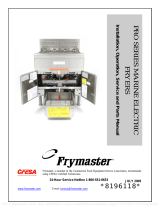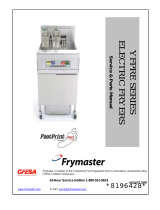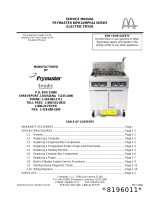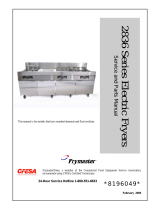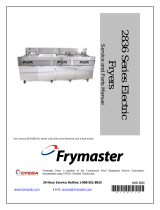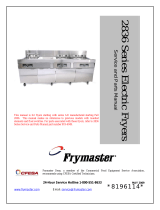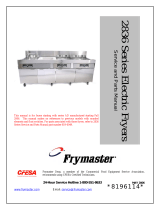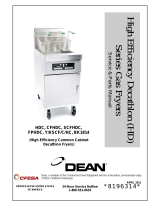Page is loading ...

Frymaster, a member of the Commercial Food Equipment Service Association, recommends
using CFESA Certified Technicians.
24-Hour Service Hotline 1-800-551-8633
MAY 2006
*8195990*
PRO SERIES
ELECTRIC FRYERS
Service & Parts Manual

i
NOTICE
IF, DURING THE WARRANTY PERIOD, THE CUSTOMER USES A PART FOR THIS ENODIS
EQUIPMENT OTHER THAN AN UNMODIFIED NEW OR RECYCLED PART PURCHASED DIRECTLY
FROM FRYMASTER/DEAN, OR ANY OF ITS AUTHORIZED SERVICE CENTERS, AND/OR THE
PART BEING USED IS MODIFIED FROM ITS ORIGINAL CONFIGURATION, THIS WARRANTY WILL
BE VOID. FURTHER, FRYMASTER AND DEAN AND ITS AFFILIATES WILL NOT BE LIABLE FOR
ANY CLAIMS, DAMAGES OR EXPENSES INCURRED BY THE CUSTOMER WHICH ARISE
DIRECTLY OR INDIRECTLY, IN WHOLE OR IN PART, DUE TO THE INSTALLATION OF ANY
MODIFIED PART AND/OR PART RECEIVED FROM AN UNAUTHORIZED SERVICE CENTER.
DANGER
Copper wire suitable for at least 167°F (75°C) must be used for power connections.
DANGER
The electrical power supply for this appliance must be the same as indicated on the
rating and serial number plate located on the inside of the fryer door.
DANGER
This appliance must be connected to the voltage and phase as specified on the rating
and serial number plate located on the inside of the fryer door.
DANGER
All wiring connections for this appliance must be made in accordance with the wiring
diagrams furnished with the equipment. Wiring diagrams are located on the inside of
the fryer door.
DANGER
Do not store or use gasoline or other flammable vapors and liquids in the vicinity of this
or any other appliance.
WARNING
Do not attach accessories to this fryer unless fryer is secured from tipping. Personal
injury may result.
WARNING
Frymaster fryers equipped with legs are for permanent installations. Fryers fitted with
legs must be lifted during movement to avoid damage and possible bodily injury. For a
moveable or portable installation, Frymaster optional equipment casters must be used.
Questions? Call 1-800-551-8633
WARNING
Do not use water jets to clean this equipment.
DANGER
All wiring connections for this appliance must be made in accordance with the wiring
diagrams furnished with the equipment. Wiring diagrams are located on the inside of
the fryer door.
WARNING
This equipment is intended for indoor use only. Do not install or operate this
equipment in outdoor areas.

ii
ELECTRICAL POWER SPECIFICATIONS
MINIMUM SIZE AMPS PER LEG
kW VOLTAGE PHASE
WIRE
SERVICE
AWG mm
2
L1 L2 L3
14 208 3 3 6 16 39 39 39
14 240 3 3 6 16 34 34 34
14 480 3 3 8 10 17 17 17
14 220/380 3 4 6 16 21 21 21
14 240/415 3 4 6 16 20 20 21
14 230/400 3 4 6 16 21 21 21
208 3 3 6 16 39 39 39
240 3 3 6 16 34 34 34
220/380 3 4 6 16 21 21 21
ALL
EPRI 14kW
(SOLID STATE)
240/415 3 4 6 16 20 20 20
17 208 3 3 6 16 48 48 48
17 240 3 3 6 16 41 41 41
17 480 3 3 6 16 21 21 21
17 220/380 3 4 6 16 26 26 26
17 240/415 3 4 6 16 24 24 24
17 230/400 3 4 6 16 25 25 25
208 3 3 6 16 48 48 48
240 3 3 6 16 41 41 41
220/380 3 4 6 16 26 26 26
ALL
EPRI 17kW
(SOLID STATE)
240/415 3 4 6 16 24 24 24
22 208 3 3 4 25 61 61 61
22 240 3 3 4 25 53 53 53
22 480 3 3 6 16 27 27 27
22 220/380 3 4 6 16 34 34 34
22 240/415 3 4 6 16 31 31 31
22 230/400 3 4 6 16 32 32 32

TABLE OF CONTENTS
Page
CAUTIONARY STATEMENTS i
ELECTRICAL POWER SPECIFICATIONS ii
CHAPTER 1 – SERVICE PROCEDURES 1-1
1.1 General 1-1
1.2 Replacing a Controller 1-1
1.3 Replacing Component Box Components 1-2
1.4 Replacing a Temperature Probe or High-Limit Thermostat 1-3
1.5 Replacing a Heating Element 1-5
1.6 Replacing Contactor Box Components 1-6
1.7 Replacing a Frypot 1-7
1.8 Built-in Filtration System Service Procedures 1-8
1.9 Basket Lift Service Procedures 1-12
1.10 Interface Board Diagnostic Charts 1-15
1.11 Wiring Diagrams 1-16
CHAPTER 2 – PARTS LIST 2-1
2.1 Accessories 2-1
2.2 Basket Lift Assembly and Associated Parts 2-2
2.3 Cabinetry 2-4
2.4 Drain System Components 2-8
2.5 Electronics and Wiring Components 2-16
2.6 Filtration System Components 2-28
2.7 Frypot Assemblies and Associated Parts 2-31
2.8 Oil Return System Components 2-33

1-1
PRO SERIES ELECTRIC FRYERS
CHAPTER 1: SERVICE PROCEDURES
1.1 General
Before performing any maintenance on your Frymaster fryer, disconnect the fryer from the electrical
power supply.
When electrical wires are disconnected, it is recommended that they be marked in such a way as to
facilitate re-assembly.
1.2 Replacing a Controller
1. Before removing controllers from Euro-look models (round top-cap and drains), slide the metal
bezel up to release the bottom tabs; then, remove it.
2. Remove the two screws from the upper corners of the control panel. The control panel is hinged
at the bottom and swings open from the top.
Remove screws in upper
corners of control panel and
swing control panel down.
3. Unplug the wiring harness from the connector on the back of the controller and disconnect the
grounding wire from terminal adjacent to the connector. Remove the control panel assembly by
lifting it from the hinged slots in the control panel frame.

1-2
4. Remove the controller from the control panel assembly and install the replacement controller.
Reinstall the control panel assembly by reversing steps 1 and 2.
1.3 Replacing Component Box Components
1. Remove the two screws from the upper corners of the control panel and allow the control panel
to swing down (see steps 1 and 2 of section 1.2 on preceding page).
2. Unplug the wiring harness from the 15-pin connector on the interface board and disconnect the
grounding wire from terminal adjacent to the 15-pin connector on the back of the controller.
Remove the control panel assembly by lifting it from the hinge slots in the control panel frame.
3. Disconnect the wiring from the component to be replaced, being sure to make a note of where
each wire was connected.
NOTE: If replacing the interface board, connectors J1 and J2 must also be disconnected from
the 12-pin connectors on the rear of the component box, directly behind the interface board.
4. Dismount the component to be replaced and install the new component, being sure that any
required spacers, insulation, washers, etc. are in place.
NOTE: If more room to work is required, the control panel frame and top cap assembly may be
removed by removing the hex head screws that secure it to the fryer cabinet (see illustration
below). If this option is chosen, all control panel assemblies must be removed per steps 1 and 2
above. The cover plate on the lower front of the component box may also be removed if desired.
Removing the component box itself from the fryer is not recommended due to the difficulty
involved in disconnecting and reconnecting the oil-return valve rods, which pass through
openings in the component box.
Ground Wire Terminal
15-Pin Connecto
r

1-3
Remove these three
screws at each end.
Remove these two screws
from the center supports.
Removing the Control Panel Frame and Top Cap Assembly
5. Reconnect the wiring disconnected in step 3, referring to your notes and the wiring diagrams on
the fryer door to ensure that the connections are properly made. Also, verify that no other wiring
was disconnected accidentally during the replacement process.
6. Reverse steps 1 and 2 to complete the replacement and return the fryer to service.
1.4 Replacing a Temperature Probe or High-Limit Thermostat
1. Remove the filter pan and lid from the unit. Drain the frypots into a Shortening Disposal Unit
(SDU) or other appropriate metal container.
DANGER
DO NOT drain more than one full frypot or two split frypots into the SDU at one time.
2. Disconnect the fryer from the electrical power supply and reposition it to gain access to the rear
of the fryer.
3. Remove the tilt housing and back panels from the fryer. The tilt housing must be removed first in
order to remove the upper back panel. To remove the tilt housing, raise the elements and allow
them to rest on the basket support racks as shown in the photo below.

1-4
Next, remove the hex head screws from the rear edge of the housing. The housing can then be
lifted straight up and off the fryer. Lift up on the upper back panel to disengage the tabs on its
upper corners from the cutouts in the fryer frame.
4. Disconnect the wire harness at connector C6 and, using a pin pusher, disconnect the probe leads
or high-limit leads from the connector.
5. If replacing a temperature probe, remove the screw securing the probe bracket to the element
and slide the bracket off the element and probe. Pull the probe out of the tilt housing assembly,
install the replacement probe, and reattach the element bracket. Secure the upper portion of the
probe with a replacement metal wire tie.
Probe Bracket
Probe Leads
Metal Wire Tie
If replacing a high-limit thermostat, unscrew the thermostat to be replaced. Apply Loctite
™
PST
567 or equivalent sealant to the threads of the replacement and screw it securely into the frypot.
6. If a temperature probe was replaced, insert the probe leads into the connector (see left
illustration below). For full-vat units or the left half (as viewed from the rear of the fryer) of a
dual-vat unit, the red lead goes into position 6 and the white into position 7. For the right half of
a dual-vat unit (as viewed from the rear of the fryer), the red lead goes into position 12 and the
white into position 13.
Rib marks Position 1
6
7
12
13
Probe Lead Positions High-Limit Lead Positions
11
10
4
5
If a high-limit thermostat was replaced, insert the leads into the connector (see right illustration
above). For full-vat units or the left half of a dual-vat unit (as viewed from the rear of the fryer),
the leads go into positions 4 and 5 of the connector. For the right half of a dual-vat unit (as
viewed from the rear of the fryer), the leads go into positions 10 and 11. In either case, polarity
does not matter.
7. Reinstall the back panels and tilt housing to complete the installation, then reverse steps 1 and 2
to return the fryer to service.

1-5
1.5 Replacing a Heating Element
1. Perform steps 1-3 of section 1.4, Replacing a Temperature Probe.
2. On dual-vat fryers, and on full-vat fryers where the temperature probe is attached to the element
being replaced, disconnect the wire harness containing the probe wiring (connector C6). Using a
pin pusher, disconnect the probe wires from the connector.
3. On the front of the contactor box, disconnect the 6-pin connector for the left element (as viewed
from the front of the fryer) or the 9-pin connector for the right element and pull the harness out
through the rear of the fryer. Press in on the tabs on each side of the connector while pulling
outward on the free end to extend the connector and release the element leads (see photo below).
Pull the leads out of the connector and out of the plastic wire loom.
4. Raise the element to the full up position and disconnect the element springs.
5. Remove the nuts and machine screws that secure the element to the tilt plate assembly and pull
the element out of the frypot. NOTE: Full-vat elements consist of two dual-vat elements
clamped together. For full-vat units, remove the element clamps before removing the nuts and
machine screws that secure the element to the tilt plate assembly.
6. If applicable, recover the probe bracket and probe from the element being replaced and install
them on the replacement element, then install the replacement element in the frypot, securing it
with the nuts and screws removed in Step 5.
7. Route the element leads through the wire loom to prevent chafing and press the pins into the
connector in accordance with the diagram below, then close the connector to lock the leads in
place. NOTE: It is critical that the wires be routed through the loom to prevent chafing.
1
4
2
5
3
6
1
4
2
5
3
6
789
5R 4R6R 1R2R3R
Pip marks Position 1
5L 4L6L 1L2L3L

1-6
Remove these screws to dismount the left contactor box.
The right contactor box is secured in a similar manner.
8. Insert the element connector into the receptacle on the front of the contactor box, ensuring that
the latches lock.
9. If disconnected in step 2, insert the temperature probe leads into the wiring harness connector
(see illustration below). For full-vat units or the right half of a dual-vat unit, the red lead goes
into position 6 and the white into position 7. For the left half of a dual-vat unit, the red lead goes
into position 12 and the white into position 13. NOTE: Right and left refer to the fryer as
viewed from the rear.
Rib marks Position 1
6
7
12
13
10. If disconnected in step 2, reconnect connector C6 of the wiring harness.
11. Reconnect the element springs and lower the element back down onto the basket rack.
12. Reinstall the tilt housing and back panels, reposition the fryer under the exhaust hood, and
reconnect it to the electrical power supply.
1.6 Replacing Contactor Box Components
1. If replacing a contactor box above the built-in filter system, remove the filter pan and lid from
the unit. Drain the frypots into a Shortening Disposal Unit (SDU) or other appropriate metal
container. If replacing a contactor box in a non-filter unit, drain the frypot above the box into a
Shortening Disposal Unit (SDU) or other appropriate metal container.
DANGER
DO NOT drain more than one full frypot or two split frypots into the SDU at one time.
2. Disconnect the fryer from the electrical power supply.
3. Unplug the wiring harnesses from the contactor box to be serviced.
4. Remove the two screws that secure the box in place. NOTE: If you remove the screws from
both boxes at the same time, the boxes will jam against each other and neither can be removed.

1-7
5. Carefully lower the box to the floor and pull it out the front of the fryer. Remove the top cover
to access contactors and other components.
6. After performing necessary service, reverse steps 1-5 to return the fryer to operation.
1.7 Replacing a Frypot
1. Drain the frypot into the filter pan or, if replacing a frypot over the filter system, into a
Shortening Disposal Unit (SDU) or other appropriate metal container. If replacing a frypot over
the filter system, remove the filter pan and lid from the unit.
DANGER
DO NOT drain more than one full frypot or two split frypots into the SDU at one time.
2. Disconnect the fryer from the electrical power supply and reposition it to gain access to both the
front and rear.
3. On Euro-look models, slide the metal bezel up to release the bottom tabs; then, remove it.
4. On all models, remove the two screws from the upper corners of the control panels and allow
them to swing down (see illustration and photo on page 1-1).
5. Unplug the wiring harnesses and ground wires from the backs of the controllers. Remove the
controllers by lifting them from the hinge slots in the control panel frame.
6. Remove the tilt housing and back panels from the fryer. The tilt housing must be removed first in
order to remove the upper back panel. To remove the tilt housing, raise the elements and allow
them to rest on the basket support racks (see photo on page 1-3).
Next, remove the hex head screws from the rear edge of the housing. The housing can then be
lifted straight up and off the fryer. Lift up on the upper back panel to disengage the tabs on its
upper corners from the cutouts in the fryer frame.
7. Dismount the top cap by removing the hex head screws at each end that secure it to the control
panel frame.
8. Remove the hex head screw that secures the front of the frypot to the cabinet cross brace.
9. Remove the top-connecting strip that covers the joint with the adjacent frypot.
10. On standard models, unscrew the Teflon vent/vacuum-breaker tube fitting, open the drain tube
cleanout covers, unscrew the retainer nuts from the drain valve nipples, and remove the tube
assembly from the fryer.
On Euro-look models, unscrew the Teflon vent/vacuum-breaker tube fitting, unscrew the nut
located on the front of each section of drain tube, and remove the tube assembly from the fryer.
11. Remove the covers from the drain safety switch(es) and disconnect the switch wiring at the
switch(es).

1-8
12. At the rear of the fryer, unplug the C6 connector and, using a pin pusher, disconnect the high-
limit thermostat leads.
13. Disconnect the oil return flexline(s) at the frypot end(s).
14. Raise the elements to the “up” position and disconnect the element springs.
15. Remove the machine screws and nuts that secure the tilt plate and element assembly to the
frypot. Carefully lift the tilt plate and element assembly from the frypot and secure it to the cross
brace on the rear of the fryer with wire ties or tape.
16. Carefully lift the frypot from the fryer and place it upside down on a stable work surface.
17. Recover the drain valve(s), oil return flexline connection fitting(s), and high-limit thermostat(s)
from the frypot. Apply Loctite
™
PST 567 or equivalent sealant to the threads of the recovered
parts and install them in the replacement frypot.
18. Carefully lower the replacement frypot into the fryer. Reinstall the hex head screw removed in
step 7 to attach the frypot to the fryer.
19. Position the tilt housing and element assembly in the frypot and reinstall the machine screws and
nuts removed in step 14.
20. Reconnect the oil return flexlines to the frypot, and replace aluminum tape, if necessary, to
secure heater strips to the flexlines.
21. Insert the high-limit thermostat leads disconnected in step 11 (see illustration on page 1-4 for pin
positions).
22. Reconnect the drain safety switch wiring to the switch(es) in accordance with the diagram below
then reinstall the switch covers.
58C BLK
57C RED
RIGHT
DRAIN SAFETY SWITCH
LEFT
DRAIN SAFETY SWITCH
(DUAL-VAT ONLY)
55C BLK
56C RED
23. Reinstall the drain tube assembly.
24. Reinstall the tilt housing and back panels, top cap, and top connecting strip.
25. Reinstall controllers in the control panel frame and reconnect the wiring harnesses and ground
wires.
26. Reposition the fryer under the exhaust hood and reconnect it to the electrical power supply.

1-9
1.8 Built-in Filtration System Service Procedures
1.8.1 Filtration System Problem Resolution
One of the most common causes of filtration problems is placing the filter paper on the bottom of the
filter pan rather than over the filter screen.
CAUTION
Ensure that filter screen is in place prior to filter paper placement and filter pump
operation. Improper screen placement is the primary cause of filtration system
malfunction.
When the complaint is “the pump is running, but no oil is being filtered,” check the installation of
the filter paper and ensure that the correct size is being used.
If the pump motor overheats, the thermal overload will trip and the motor will not start until it is
reset. If the pump motor does not start, press the red reset switch (button) located on the rear of the
motor at the front of the fryer.
If the pump starts after resetting the thermal overload switch, then something is causing the motor to
overheat. A major cause of overheating is when several frypots are filtered sequentially, thus
overheating the pump and motor. Allow the pump motor to cool at least 30 minutes before resuming
operation. Pump overheating can be caused
by:
• Solidified shortening in the pan or
filter lines, or
• Attempting to filter unheated oil
(cold oil is more viscous,
overloading the pump motor and
causing it to overheat).
If the motor runs but the pump does not,
there is a blockage in the pump. Incorrectly
sized or installed paper/pads will allow food
particles and sediment to pass through the
filter pan and into the pump. When
sediment enters the pump, the gears bind,
causing the motor to overload, again
tripping the thermal overload. Shortening
that has solidified in the pump will also
cause it to seize, with the same result.
A pump seized by debris or hard shortening
can usually be freed by manually moving
the gears with a screwdriver or other
instrument.
Sediment Particle
Oil Flow
Up for reverse
Down for forward
Sediment Particle

1-10
Disconnect power to the filter system, remove the input plumbing from the pump, and use a
screwdriver to manually turn the gears.
● Turning the pump gears in reverse will release a hard particle.
● Turning the pump gears forward will push softer objects and solid shortening through the
pump and allow free movement of the gears.
Incorrectly sized or installed paper/pads will also allow food particles and sediment to pass through
and clog the suction tube on the bottom of the filter pan. Particles large enough to block the suction
tube may indicate that the crumb tray is not being used. Pan blockage can also occur if shortening is
left in the pan and allowed to solidify. Blockage removal can be accomplished by forcing the item
out with an auger or drain snake. Compressed air or other pressurized gases should not be used to
force out the blockage.
1.8.2 Replacing the Filter Motor, Filter Pump, and Related Components
1. Remove the filter pan and lid from the unit. Drain the frypots into a Shortening Disposal Unit
(SDU) or other appropriate metal container.
DANGER
DO NOT drain more than one full frypot or two split frypots into the SDU at one time.
2. Disconnect the fryer from the electrical power supply and reposition it to gain access to both the
front and rear.
3. Remove the two lower back panels, unplug the wiring harnesses from the contactor boxes, and
remove the two screws that secure one of the boxes in place (it doesn’t matter which one; see
illustration on page 1-6). NOTE: If you remove the screws from both boxes at the same time,
the boxes will jam against each other and neither can be removed.
4. Carefully lower the box to the floor and pull it out the front of the fryer. Remove the remaining
box following the same procedure.
5. Disconnect the two flexlines running to the oil-return manifold at the rear of the fryer. Remove
the nut and bolt that secures the bridge to the oil-return manifold.
Disconnect Pump
Solenoid flexline here.
Disconnect Vacuum-Breaker
Solenoid flexline here.

1-11
6. Disconnect the pump suction flexline at the end of the filter pan connection.
Disconnect Pump
Suction flexline here.
7. Remove the cover plate from the front of the motor and disconnect the motor wires.
8. Unplug the 15-pin connector from the rear of the left component box and, using a pin pusher,
disconnect the solenoid valve wires (pins 4, 6, 10 and 12). NOTE: If the vacuum-breaker
solenoid valve is connected to the manifold rather than the pump, its wires (pins 4 and 6) do not
need to be disconnected.
9. Remove the two nuts and bolts that secure the front of the bridge to the cross brace and carefully
slide the bridge rearward off the cross brace until its front end can be lowered to the floor. Be
careful not to let the rear of the bridge slip off the manifold at this point. NOTE: In some early
production units, the bridge will not slide far enough to the rear to clear the front brace. In such
cases, the front brace must be removed. It is held in place by two hex head screws on each end
and a nut and bolt inside the brace near each end.
10. Get a good grip on the bridge, carefully pull it forward off the oil-return manifold, and lower the
entire assembly to the floor. Once on the floor, pull the assembly out the front of the fryer.
11. When required service has been completed, reverse steps 6-12 to reinstall the bridge. NOTE:
The black motor wires go on the top terminal, the white on the bottom. The pump solenoid valve
wires go in positions 10 and 12 of the 15-pin connector; the vacuum-breaker solenoid valve
wires go in positions 4 and 6. In both cases, polarity does not matter.
12. Once the bridge is back in place, reverse steps 4 and 5 to reinstall the contactor boxes.
13. Reconnect the unit to the electrical power supply, and verify that the pump is functioning
correctly (i.e., when a filter handle is placed in the ON position, the motor should start and there
should be strong suction at the intake fitting and outflow at the power shower or rear flush port).
14. When proper operation has been verified, reinstall the back panels and the filter pan and lid, and
return the fryer to service.

1-12
1.8.3 Replacing the Filter Transformer or Filter Relay
Remove the left controller from the fryer to expose the interior of the left component box. The filter
transformer and relay are located as shown in the illustration below. NOTE: The right component
box is identical to the left except that the filter transformer and relay are not present.
Filter
Relay
Filter
Transformer
Dual-vat configuration illustrated. In full-vat units, left filter handle is not present.
1.9 Basket Lift Service Procedures
Pro Series electric fryers may be equipped with automatic basket lifts. Basket lifts always come in
pairs, although each operates independently.
A modular basket lift (illustrated below) is a self-contained sub-assembly consisting of a pair of
toothed rods which support removable basket lift arms, a pair of reversible-drive gear motors, and
four microswitches. The gear motors engage the teeth of the rods, moving them up or down
depending upon the motors’ direction of rotation. The microswitches at the upper and lower limits
of movement stop the motors when the basket is in the full up or full down position.
Timing circuitry in the controller initiates and stops basket lift operation depending upon the
variables programmed by the operator. When the product button is pressed, the timing circuitry
activates a coil in the basket lift relay to supply power to the lower microswitch. The microswitches
stop the motor at the lift’s upper and lower travel limits and reverse the direction of current flow thus
reversing the motor direction.
When the product button is pushed on the computer/controller, current flows through a coil in the
basket lift relay, causing the lower circuit to be activated. The basket lift lowers, closing the
normally open upper-micro-switch. When the downward-moving rod opens the lower normally
closed microswitch, power to the motor ceases to flow. When the computer/controller times out, the
current to the relay coil is cut, allowing the upper circuit to be activated. The basket lift then raises
and re-closes the lower microswitch. When the basket lift rod clears the upper microswitch, the
microswitch reopens, power to the circuit is cut, and the motor stops. Pushing the product button
restarts the cycle.

1-13
100-120V Configuration
208-250V Configuration
Problems with the basket lift can be grouped into three categories:
● Binding/jamming problems
● Motor and gear problems
● Electronic problems
BINDING/JAMMING PROBLEMS
Noisy, jerky or erratic movement of the lifts is usually due to lack of lubrication of the rods and their
bushings. Apply a light coat of Lubriplate
®
or similar lightweight white grease to the rod and
bushings to correct the problem.
With the modular basket lift, another possible cause of binding is improper positioning of the motor,
which prevents the gear from correctly engaging the teeth in the rod. To correct the problem, loosen
the screws that hold the motor in place and move it forward or backward until the rod has just
enough slack to be rotated slightly.
MOTOR AND GEAR PROBLEMS
With the modular basket lift, the most likely problem to be encountered in this category is erratic
motion of the lift due to a worn drive gear. Failure to keep the lift rod and bushings properly
lubricated will cause unnecessary wear of the gear. The problem is corrected by replacing the worn
gear.
If the lift cycles correctly but fails to remain in the up position (i.e., goes up, but then slowly settles
back down into the frypot), the problem is a failed motor brake. A failed motor brake cannot be
repaired and requires replacement of the motor itself.
If power is reaching the motor but the motor fails to run, the motor is burned out and must be
replaced.

1-14
ELECTRONIC PROBLEMS
Within this category are problems associated with the relays, microswitches, capacitors, resistors,
interface board, wiring, and controls. The most common problem in this category is a lift that
continuously travels up and down. This is usually caused by a microswitch that is out of adjustment.
Troubleshooting the electronics of a modular basket lift is simply a process of verifying current flow
through the individual components up to and including the motor. Using a multimeter set to the 250
VAC range, check the connections on both sides of the component for the presence of the applied
line voltage. The schematic below and the wiring diagram on page 1-15 identify the components
and wiring connection points.

1-15
1.10 Interface Board Diagnostic Chart
The following diagram and charts provide ten quick system checks that can be performed using only
a multimeter.
Meter Setting Test Pin Pin Results
12 VAC Power 50 VAC Scale 1 of J2 3 of J2 12-16 VAC
24 VAC Power 50 VAC Scale 2 of J2 Chassis 24-30 VAC
*Probe Resistance (RH) R X 1000 OHMS 11 of J2 12 of J2 See Chart
*Probe Resistance (LH) R X 1000 OHMS 3 of J1 2 of J1 See Chart
Hi-Limit Continuity (RH) R X 1 OHMS 7 of J2 4 of J2 0 - OHMS
Hi-Limit Continuity (LH) R X 1 OHMS 4 of J1 7 of J1 0 - OHMS
Latch Contactor Coil (RH) R X 1 OHMS 8 of J2 Chassis 3-10 OHMS
Latch Contactor Coil (LH) R X 1 OHMS 5 of J1 Chassis 3-10 OHMS
Heat Contactor Coil (RH) R X 1 OHMS 9 of J2 Chassis 18-25 OHMS
Heat Contactor Coil (LH) R X 1 OHMS 6 of J1 Chassis 18-25 OHMS
* Disconnect 15-Pin harness from the computer/controller before testing the probe circuit.
Diagnostic LED Legend
CMP indicates power from 12V transformer
24 indicates power from 24V transformer
HI (RH) indicates output (closed) from right latch
relay
HI (LH) indicates output (closed) from left latch
relay
HT (RH) indicates output from right heat relay
HT (LH) indicates output from left heat relay
AL (RH) indicates output (open) from right latch
relay
AL (LH) indicates output (open) from left latch
relay
1
23
4
5
6
8
7
9
10
11
12
13
14
15
1
2
3
4
5
6
7
8
9
10
11
12
1
2
3
4
5
6
7
8
9
10
11
12
K1
K2
K3 K4
Left
Latch
Relay
Right
Latch
Relay
Left
Heat
Relay
Right
Heat
Relay
Test Points
J1 Left J2 Right
Diagostic LEDs
M
H
N
Normally Closed Lower-limit
Microswitch
6
To computer/controller via
interface board
Basket Lift
Relay
3
1 or 4
5
Normally Open Upper-limit
Microswitch
Modular Basket Lift Schematic

1-16
1.11 Wiring Diagrams
BASKET LIFT
/
